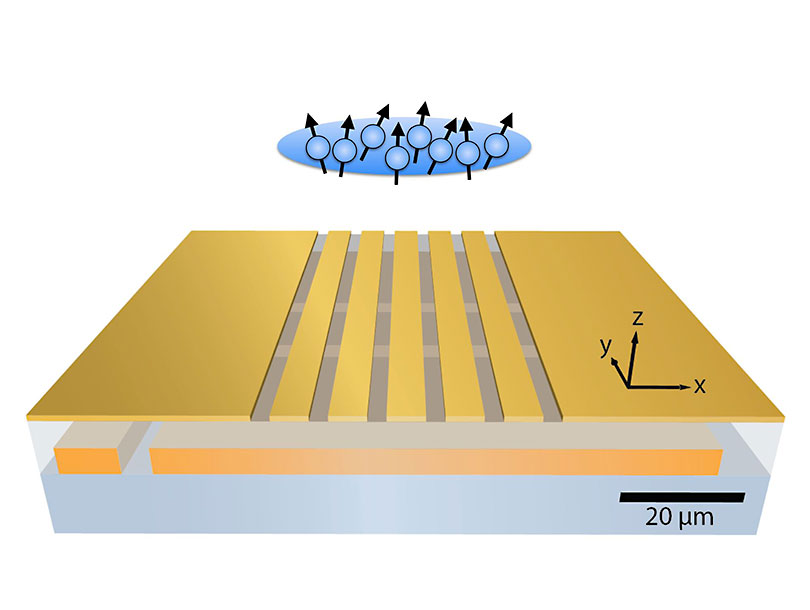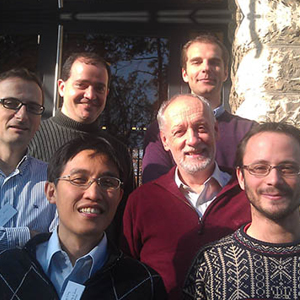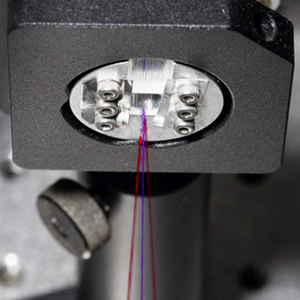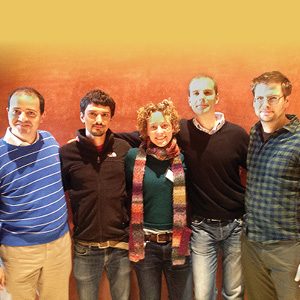Highlights
Result smashes size record for quantum correlations

Bell correlations were detected in clouds of about 480 ultracold Rubidium atoms trapped above a microchip. Previously the biggest system in which such correlations had been observed was just 14 ions. Illustration: University of Basel, Department of Physics
CQT researchers have contributed to finding the strongest form of quantum correlations in the biggest system yet. The research is described in the paper "Bell correlations in a Bose-Einstein condensate" published 22 April in Science.
In collaboration with researchers at the University of Basel in Switzerland, CQT theorists Jean-Daniel Bancal and Valerio Scarani found evidence of Bell correlations in an ultracold cloud of about 480 atoms.
Bell correlations are those which defy our perception of the Universe being 'local': the particles' properties depend on each other in ways that can't be explained by communication between them or have been set in advance. Before being measured, the atoms' properties are not only unkown – they do not even exist.
Size matters
The result smashes the size record for systems showing such behaviour. The biggest system in which Bell correlations had been detected previously comprised just 14 ions. In other quantum systems, correlations had been found only in even smaller ensembles of four (photons) and two (netural atoms, solid state spin qubits, Josephon phase qubits).
Bell correlations don't just have having philosophical implications, they have practical applications too. Technologies such as quantum key distribution and certified random number generation rely on them for security. The authors suggest that exploiting Bell correlations in a big, many-body quantum system could have advantages: for example, generating more randomness per experimental run.
The reason big quantum systems hadn't been studied before is that characterizing their correlations would seem to require measuring each particle individually, which is beyond current technology. The new work builds on a 2014 paper, also published in Science, by Jordi Tura and co-authors in Spain and Hungary. The authors proposed Bell inequalities for many-body systems that relied only on easy-to-measure two particle correlations – but did not go as far as suggesting a specific experiment.
Jean-Daniel was visiting theorists in Basel when together they spotted a way to proceed. "They found out that the family of Bell inequalities proposed by Tura and coworkers can be violated by a family of quantum states that are not difficult to produce in the lab, the so-called squeezed spin states. It was, in a sense, our luck that the authors of the original paper missed this family of states. With this observation, they convinced the experimental group to set out and perform the measurements," says Valerio. Jean-Daniel is now a Senior Scientist in the Basel group.
Uncharted territory
The measurements were made on clouds of Rubidium atoms trapped above a microchip and cooled with laser light down to a few billionths of a degree above absolute zero (see picture). The atoms in the cloud constantly collide, causing their magnetic moments to become slowly entangled. When this entanglement gets strong enough, Bell correlations can be detected.
Getting the result was an interdisciplinary effort, which added to the challenge. The authors come from two different communities – quantum information and many-body physics. Valerio says "We discovered that the two communities would be looking for different pieces of information, both in the text and in the data presented, and we had to find a compromise that would make the paper convincing for both."
The work lays a foundation for further research. Author Philipp Treutlein from the University of Basel says "Bell correlations in many-particle systems are a largely unexplored field with many open questions – we are entering uncharted territory with our experiments."
Related Stories
 | Looking beyond space and time to cope with quantum theory October 29 2012 |
 | Experiment records extreme quantum weirdness November 09 2015 |
 | CQT researchers contribute to review of quantum nonlocality June 10 2014 |






